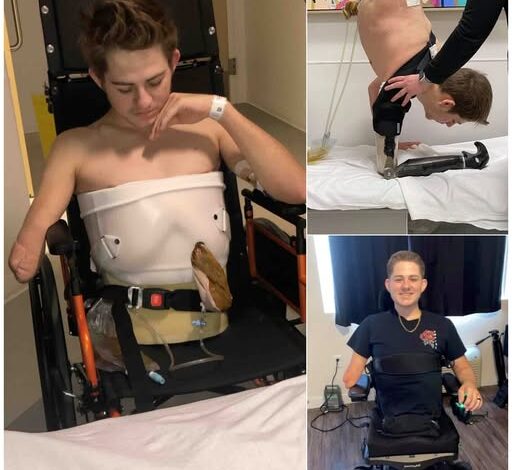When floodwaters began to rise in a small American town last Monday, no one could have predicted that the day would reveal a story of courage, compassion, and unexpected heroism. Within minutes, what had been a routine afternoon commute turned into a desperate fight for survival — and a reminder that heroes often appear where we least expect them.
It began with a school bus, carrying a group of kindergartners home after class. As the rain poured harder and streets began to flood, the driver attempted to navigate a low-lying road. But the water came faster than anyone anticipated. Within moments, the bus was trapped, half-submerged, unable to move forward or backward. The terrified teacher and driver shouted for help as water surged through the doors, quickly rising toward the children’s seats.
Witnesses say most bystanders froze in shock. Some shouted for help, while others pulled out their phones to record the unfolding chaos — a reflex common in today’s digital age. Amid the confusion and panic, few knew what to do. The teacher, standing waist-deep in water, tried to calm the crying children, but her own fear was visible in her trembling hands. The situation was growing desperate.
Then came the unmistakable roar of motorcycles cutting through the storm. A group of leather-clad bikers appeared at the edge of the flooded road, their headlights slicing through the rain. To many onlookers, they seemed out of place — large, tattooed men with heavy boots and chain belts, the kind of figures often misjudged by stereotypes. But within seconds, they were off their bikes and running toward the bus.
Without hesitation, they plunged into the murky, fast-moving water. One of them, later identified only by his nickname “Tank,” began pounding on the bus’s emergency exit with his bare fists. Another biker, “Reaper,” grabbed hold of a branch wedged against the side of the bus to steady himself as the others formed a human chain. Working together, they created a line from the bus to dry ground, holding firm against the rushing current.
“None of us thought about danger,” one of the bikers later told reporters. “We just saw kids inside and knew we had to move.”
As Tank smashed open the rear exit, the teacher began passing children toward the waiting arms outside. The bikers worked in perfect rhythm, each grabbing a child and passing them down the line until they reached safety. The rain blurred faces and drenched everyone, but no one stopped. Dozens of onlookers began to cheer, their phones forgotten, as one by one the children were pulled from the sinking bus.
Then came a small voice that silenced the crowd. A girl named Mia, clutching her backpack and shaking from cold, cried out, “My brother! He’s still inside!”
Without hesitation, Tank turned back toward the bus. Ignoring calls to wait, he dove beneath the water and disappeared into the dark interior. Seconds passed — then a minute. The crowd held its breath. When he finally emerged, Tank was holding a small boy against his chest. The man’s arms were bleeding from broken glass, but his grip was strong and steady. The crowd erupted into applause as he carried the boy to his sister’s side.
Paramedics arrived soon after. All the children were checked for injuries and found to be safe. The bus driver and teacher, though shaken, credited the bikers with saving every life that day. “They didn’t hesitate,” the teacher said tearfully. “They didn’t care about who was watching or what anyone thought. They just acted.”
Local authorities later confirmed that the group of rescuers were members of a motorcycle club known for charity rides and community service events. Despite their rough appearance, they had long supported local schools and shelters. But that day, their actions spoke louder than any reputation or label.
Photos of the rescue — soaked bikers carrying frightened children through waist-high water — quickly spread across social media. Within hours, the story had gone viral. Thousands of users shared posts with captions like
“Real heroes wear leather, not capes” and “Never judge a book by its cover.” The image of Tank, kneeling beside Mia and her brother, became an instant symbol of courage and compassion.
As news outlets across the country picked up the story, interviews revealed more about the men behind the act. Tank, whose real name is not widely known, brushed off the praise. “We didn’t do it to be heroes,” he said. “We just happened to be there, and those kids needed help. That’s all.”
Psychologists and community leaders later pointed to the event as an example of instinctive altruism — the human capacity to act selflessly in moments of crisis. “When faced with danger, some people freeze, others flee, but a few step forward,” one expert noted. “These bikers reminded us that courage often comes from the most unexpected places.”
In the days that followed, the local community organized a thank-you event for the rescuers. The children’s parents presented them with handwritten cards and a framed photo of the rescue. Tank, visibly moved, said simply, “We didn’t save kids to be thanked. But this… this means a lot.”
The flood eventually receded, but the story endured — a powerful reminder that appearances can deceive, and that true heroism isn’t about uniforms, fame, or perfection. It’s about action. It’s about the moment when someone chooses to run toward danger instead of away from it.
That rainy afternoon, a bus full of kindergartners learned what bravery looks like. And a group of bikers — men often judged by their tattoos and leather jackets — proved that compassion rides on two wheels, roaring through the storm when it matters most.


